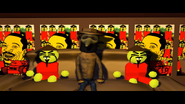"Eskimos" is a name given by Marge to a group of four men who robbed her and Maggie.

Characteristics[]
The "Eskimos" resembled cartoonish men with yellow skin and smooth black moustaches. One of the "Eskimos" has a photographed face of a European. The "Eskimos" dress like stereotypical Chinamen, each wearing red clothes and a Chinese conical hat.
They speak in a gibberish that resemble a mixture of Chinese dialects and Japanese.
History[]
In "Snospis Eht: Dreams Again.", Marge had just finished shopping with Maggie, when she stumbled upon the "Eskimos" and their car. They were talking to each other, before one of them shoots Marge with his gun eight times, and leaves her for dead. The "Eskimos" then drive off after robbing Marge of her goods and abducting Maggie.
In "A Christmas Carol", they were celebrating Christmas with Maggie in a red trailer when Mantra Claus and Mr. Scrooge brought a Christmas tree to them.
Appearances[]
Gallery[]
Trivia[]
- "Eskimo" is an older term for the Inuit peoples (Inuktitut: "Inuit", ᐃᓄᐃᑦ; singular: "Inuk", ᐃᓄᒃ), who live in the cold polar lands of northern Canada, Alaska, Greenland, and parts of eastern Russia, with some Inuit who go to Denmark for educational purposes. Many of them live by hunting animals, fishing, and sailing, but are mostly modernized. Many of them also suffer from poverty, but they are revitalizing their native culture. The term "Inuit" is not accepted by the Yupik of Alaska, and the term "Eskimo" is considered offensive to Inuit from Canada and Greenland.
- These "Eskimos" of Snospis Eht resemble stereotypes of Chinese people, except with one of them having the photoshopped face of an Englishman wearing glasses.
- Speaking of which, since Tyksrr was colonized by Chinese people in 1200 BC, these "Eskimos" might have the honor of being descendants of these colonists, and their gibberish would be a descendant language of ancient Chinese (hence it sounding too bizarre to resemble any modern Chinese dialect).[1]






